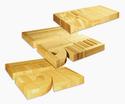Wooden Unit BlocksShopping Cart
Drag and drop
your items here  We accept these payment options plus PayPay Credit |
Environmental ResponsibilityFrom Cradle to Cradle — The new product lifecycle.We believe in environmental responsibility from beginning to, well, new beginning.That’s why everything we make is made to last. Every unit block is made to meet today’s environmental and safety requirements — and to meet requirements that may be conceived in the future. Our unit blocks exceed CPSIA safety requirements.We use only Hard Rock Maple for our unit blocks. This is the material of choice for baby rattles, teethers, and toddler toys due to its track record for safety, particularly among children with severe allergies. We just say, “No, thank you.” to rubberwood and borates in our unit blocks. Economy and name brand blocks sold in many stores use soft rubberwood that is soaked in borates during the logging process. Although borates are relatively benign according to our government, the European Union has identified this class of chemicals as carcinogens and potential endocrine disruptors. Although borates (often found in laundry detergent in the United States) might not be the worst group of chemicals in your closet, we just don’t think they’re suitable for wooden blocks that an infant or toddler may put in her mouth. We chose domestically sourced Hard Rock Maple instead. Pure environmentalism: Trees first.Ask yourself, which comes first? The tree or the unit block? Where do we protect the wildlife habitat? In a forest? Or in a warehouse after the forest has been cut down? As obvious as this sounds, some unit block manufacturers are green-wiping themselves starting at the wrong end of the supply chain. We demonstrate our environmental commitment by using FSC® 100% certified wood whenever it's available. Unlike the certification used by other manufacturers, this certification starts with the trees themselves.The FSC® 100% certified wood starts with a FSC® 100% certified tree at its source, from FSC®-certified land, logged by FSC®-certified lumberjacks, and follows the wood forward, through the supply chain, to our FSC®-certified supplier. When we are unable to find FSC® 100%, we opt for FSC® Mix Credit, which keeps the total wood volume harvested from FSC® certified forests the same as FSC® 100%. FSC® Mix Credit allows lumber mills and wholesalers to store FSC® certified wood and non-FSC® certified wood (certified as Controlled Wood) in the same pile or area, and pull out the same quantity of FSC® certified wood they put in, labelling that as FSC® Mix Credit. Although a specific board may not have started as FSC® certified, the impact of a purchase of FSC® Mix Credit wood has the same impact in the forests as a purchase of FSC® 100%. We do not use FSC® Mix certification designed for recycling which has been used to certify "recycled" wood from rubberwood plantations and products made from a mix of sources. We do not use FSC® Mix (%) certification that allows companies to mix FSC and non-FSC wood and then sell as FSC® Mix (%) based on the percentage of FSC® Mix Credit or FSC® 100% that that was mixed in. I our opinion, this dilutes the impact of FSC®. We choose FSC® certification because, at the moment, it’s the best certification available for exactly the reasons stated above. We recognize that there are instances of FSC® certified wood coming from controversial forests. We are impressed with the Forest Stewardship Council® for revoking certification where FSC® guidelines are not followed. With hypoallergenic wood certified from the source, our blocks are compatible with LEED and other green building certifications and indoor environmental quality standards, which can be a big plus for any new construction, retrofit projects, and classroom upgrades. Postal environmentalism: Blocks by mailbox.Our environmental commitment doesn’t end with our products. We also chose to reduce our environmental impact by using the United States Postal Service as our shipping partner. For most orders, we’re not paying to send a big brown delivery truck to your location, just a box. We’re shrinking our footprint by using the shipper who is already on your street six days a week. We’re not saying that the USPS uses the most energy efficient delivery schedule or vehicles (though they’re working on it). We’re just recognizing that they’re already everywhere we want to be. As a practical mater, we’re not big enough to increase USPS mileage, but we are big enough to reduce energy consumption of other shipping carriers by choosing USPS, reducing our actual environmental impact. Actually, you made us look it up. International shipper DHL says that the USPS uses the most environmentally responsible delivery methods: “The USPS operates the country’s largest civilian fleet of alternative fuel vehicles and makes one-third of their deliveries on foot.” We’re also impressed by their newest Priority Mail and Regional Priority Mail options which are not only cost-effective but also include Cradle-to-CradleCM certified packaging. “The Postal Service is the first shipping company to achieve Cradle-to-CradleCM certification for our packaging. It’s recyclable, of course. But it’s much more. This is environmental “big picture” certification. It starts at the design stage, considers energy and water use through manufacturing, and ends with a product that can be safely recycled. Cradle-to-CradleCM certification comes from McDonough Braungart Design Chemistry.” 
Featured Standard Unit Blocks: Carolina Pratt Wooden Block SetsWe recommend these sets of wooden blocks for Toddlers, Preschools, Elementary School Classrooms, and Private Homes.
CP31 Preschool Center Unit Blocks Set in Hard Rock Maple
 150-Block Classroom or Family Unit Blocks Set for 3 builders
150-Block Classroom or Family Unit Blocks Set for 3 builders
|